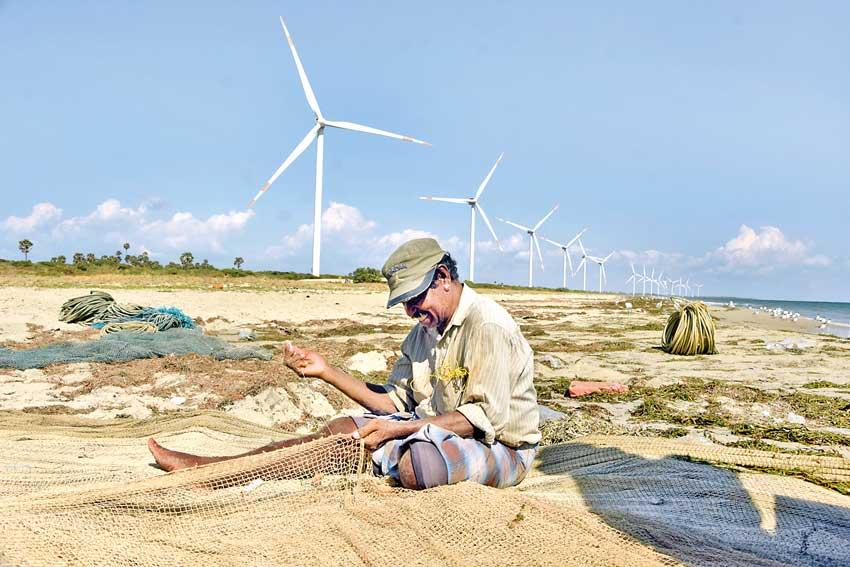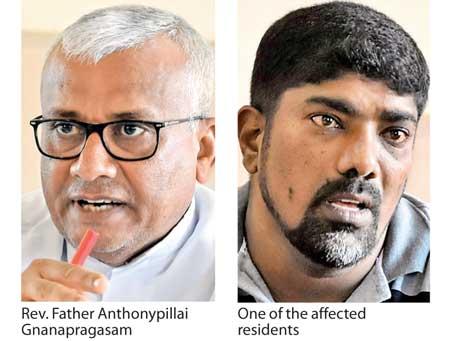27 Apr 2023 - {{hitsCtrl.values.hits}}

Pix by Nimalsiri Edirisinghe
We are not against renewable energy projects, but we don’t want them here in Mannar
There will be no further extensions or new turbine installations in the future.
-100% no to Ilmenite sand mining: MCC leader
 Suddenly the remote fishing hamlet on the Mannar Island found their lives in chaos. The Wind Turbine Power plant project jointly implemented by the Ceylon Electricity Board (CEB) and the Adani Group of India is standing at their doorstep and staring right into their eyes and livelihood.
Suddenly the remote fishing hamlet on the Mannar Island found their lives in chaos. The Wind Turbine Power plant project jointly implemented by the Ceylon Electricity Board (CEB) and the Adani Group of India is standing at their doorstep and staring right into their eyes and livelihood.
Listening to the woeful stories of the people of this hamlet -although wind turbines are now touted as green energy and “environmentally friendly”-we realise these too come with their own environmental and human problems. Some foreseen. Many unforeseen.
According to the villages of this Mannar Island, the wind farm project has completely overturned their lives.
Wind power is one of the fastest-growing renewable energy technologies. As part of the world’s renewable energy projects, Sri Lanka’s first large-scale wind farm is now established in Mannar, located on the southern coast of Mannar Island. Mannar is an island with 27.85 square kilometres of land.
As a first step, 100 MW of wind power have been developed. The project comprises 30 state-of-the-art wind turbines, each rated at 3.45 MW, and the total installed capacity of this wind farm is 103.5 MW.
 The first phase was commissioned on December 8, 2020, under the name Thambapawani -which supplied 30 MW- and was connected to the national grid.
The first phase was commissioned on December 8, 2020, under the name Thambapawani -which supplied 30 MW- and was connected to the national grid.
Funds raised as a loan from the ADB (Asian Development Bank) were used for this project and are expected to establish an additional 20 MW of wind power at the same location.
The Daily Mirror team visited Mannar along with the members of the Center for Environmental Justice (CEJ), an NGO that monitors Environemtal issues.
We observed the wind power project that was already being installed and another wind power project to be implemented soon and as well as the environmental damage that had already been caused on Mannar Island due to the projects.
During the visit, we met several villagers, fishermen, and the President of the Mannar Citizens’ Committee (MCC), Rev. Father Anthonypillai Gnanapragasam.
Renewables like wind power projects too come with an environmental and human cost. Many people in the area have already begun to feel the effects of the wind farm.
The people in the area claim that considering the way of the installation of the 30 wind turbines, humans can no longer exist on the island as most of the land is now occupied by tall gigantic turbines.
Anomalies
People on the island said that they had to face several environmental anomalies such as heavy floods, which they had never experienced before in their life.
“Sand dunes have levelled off, our groundwater (Which used to be fresh) has become salty, and most importantly there is a steep drop in the amount of catch along the coast, after the installations of the turbines,” a fisherman said.
According to the Environmental Impact Assessment (EIA) prepared by the Mannar Community, human settlement within 300 metres radius of a single wind turbine is not possible because of the noise that is emitted by the blades of the wind turbines.
A total of 1,470 acres of land had been taken for the installation of 21 wind turbines (The land taken by a wind turbine is 70 acres).
They claimed that the land where the wind farm is situated belonged to the people and private land and was not Crown Land as claimed by the Government.
“People owned this land for generations. Now the project is moving to the middle of the land which is our private lands,” one resident said.
“They already have put up a notice in the area which claims that the area is reserved as Government property.
The notice claims
“We are going to acquire the land and if there is any objection please let us know,” Father Anthonypillai Gnanapragasam said.
The report pointed out that high-voltage (HV) and medium-voltage (MV) transmission lines posed a threat to humans as well.
Accordingly, all these areas acquired by the wind power project will become hostile to human habitation on the island.
“The Government did not pay any compensation for acquiring the lands. These high tension overhead lines were constructed over the lands of the people without following proper protocols,” Rev. Father Gnanapragasam said.
“The northern side of Mannar Island was fully occupied by our community. Now our community cannot expand further because of this project,” residents said.
Meanwhile, they also brought up other issues connected to the wind turbine project.
Several roads had been built along the coastal line to complete the projects. These new roads now act like a barrier between the sea and land preventing the free flow of rain as the roads had been raised two feet above the coastal line, they said.
“During rains, villages are flooded. The people in the area had raised this flooding issue as the first problem they faced after the installation of the wind turbines,” he said.
Where are all the fish?
As the second issue, they raised the fact that there is a decline in the catch off the shores.
Many of the residents in the area are traditional fishermen and have been fishing in the seas off Mannar for generations and know nature inside out.
They said that there was a clear drop in the fish population in the seas after the project started.
“We do not know whether there is any correlation to the fish harvest, but we know that the fish harvest is on the decline.
“We have fished in the area for ages, and we know the harvest patterns and the seasonal fishing from experience,” one fisherman said.
“We have complained to the authorities in this regard, and several investigations have been conducted. But no report was released yet, and the authorities claim that no such situation had emerged in the area after the installation of the wind turbines.
“We used to catch five-tractor-loads of fish during the season, but now we cannot even get one tractor load,” one fisherman said.
“The vibration caused during the drilling could have made shoals swim away from their natural habitats from the coastal line,” Father Gnanapragasam said.
Members of the fishing community also claimed that they handed over a petition with 1,000 signatures to the Mannar District Secretariat, claiming that they did not want this project to be installed in their area.
“However, under the pressure of the Government, the project continued,” one said.
Probe
A delegation of officials who visited the area collected details about the cause of the issue and said that an immediate report would be issued in this regard to determine whether the sound had caused any impact on the decline of the fish harvest.
“But the report never come up,” Father Gnanapragasam said.
“The wind turbine project had levelled the under-sea dunes, which provided protection against high winds during the monsoon and which helped to prevent soil erosion. The dunes were levelled and there are now artificial dunes, which go against nature and disrupt the fish population,” one said.
Water, water
The Mannar island, especially the Pesalai area, is rich in groundwater.
“We can find good water in the shallow area after digging a maximum of 15 feet. The saltwater level is beyond that. By piling activities for the 25-foot depth of the project, there is a higher possibility of mixing the pure water level with the salty water. The local people never dug wells or bore wells to greater depths, as 25 feet. If both the groundwater and salt water are mixed, our drinking water wells will be polluted.
During the first phase of wind turbine construction, there were no strict mechanisms available to monitor, where the excavation sand was taken. As Mannar is a low-lying area, activities such as heavy excavation should not be permitted.
“Among all the reasons, the wind power project was completed, and it is vital to access long-term impacts on our environment, such as noise, light, water, air, land, soil, and radioactive pollution, as we relate them to the long term future,” Father Gnanapragasam said.
The Government is now talking about Phase 2 and 3 that is expected to be implemented soon.
Ilmenite
“We are not against the renewable energy projects. We are opposed because we have reasons. Mannar is known for its Ilmenite. An Australian company came to Mannar Island and collected sand samples and said that there was USD 5 billion worth of ilmenite on the island.
“We have oil reserves near the Mannar basin. We have high wind potential. With all the aspects considered, the Government is trying to make the island a desert. The Government should implement projects after discussing with all stakeholders,” Father Gnanapragasam said.
Meanwhile, another renewable energy project has been awarded to India’s Adani Group for two wind energy projects to be developed in the Mannar and the Pooneryn areas.
The Adani wind power plant in Mannar will operate at a capacity of 250 MW, while the wind power plant in Pooneryn will operate at a capacity of 100 MW.
The Government has installed wind turbines in the southern part of the island, and the Adani Group is planning to build another set of wind power plants in the northern part of the island.
“All the economic development plans on the Mannar island are wrong and those plans are not considering the local community but always thinking of the national policy while ignoring our people,” people said.
MCC President Father Gnanapragasam claimed that the Mannar people were neglected by the Government in every way possible.
“The MPs of Mannar are working for the Government. We are the people who elected them. We are left alone now without a leader. Even the Government Agent is finding it very difficult to do something concerning the issues on our island,” Father Gnanapragasam said.
“The Government can find a different location other than the Mannar residential areas,” he said.
“Whatever the Government has already installed, let it be there; somehow we will tolerate the damage already caused by them. However, it is good if future projects are not installed in this region,” he said.
“We say a firm no to the Ilmenite sand mining, and there is no other option. Our people have suffered in this way for more than 35 years, and they cannot continue to suffer. There should be some end,” the father warned.
29 Apr 2024 2 hours ago
29 Apr 2024 3 hours ago
29 Apr 2024 3 hours ago
29 Apr 2024 4 hours ago
29 Apr 2024 5 hours ago